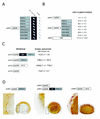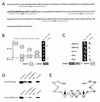Transcriptional activation by the PHD finger is inhibited through an adjacent leucine zipper that binds 14-3-3 proteins
- PMID: 10982874
- PMCID: PMC110726
- DOI: 10.1093/nar/28.18.3542
Transcriptional activation by the PHD finger is inhibited through an adjacent leucine zipper that binds 14-3-3 proteins
Abstract
The PHD finger, a Cys(4)-His-Cys(3) zinc finger, is found in many regulatory proteins from plants or animals which are frequently associated with chromatin-mediated transcriptional regulation. We show here that the PHD finger activates transcription in yeast, plant and animal cells. In plant homeodomain transcription factors the PHD finger is combined with an upstream leucine zipper. Both domains together form a highly conserved 180 amino acid region called the ZIP/PHDf motif and transcriptional activity of the PHD finger is masked when embedded in this motif. Our results indicate that the ZIP/PHDf domain is a potential regulatory domain of PHDf-HD proteins. The leucine zipper upstream of the PHD finger interacts with 14-3-3GF14 mu from Arabidopsis thaliana and 14-3-3GF14-12 from maize via a leucine zipper conserved in helix 4 of various 14-3-3 proteins from plants and animals. PHD-type plant homeodomain proteins consequently may represent potential targets of 14-3-3 signalling.
Figures




References
Publication types
MeSH terms
Substances
LinkOut - more resources
Full Text Sources
Other Literature Sources
Molecular Biology Databases
Research Materials

